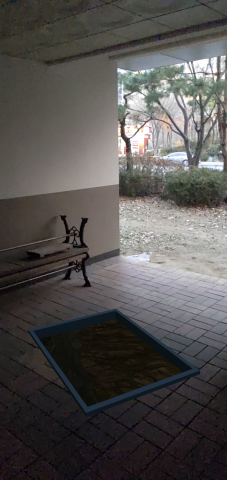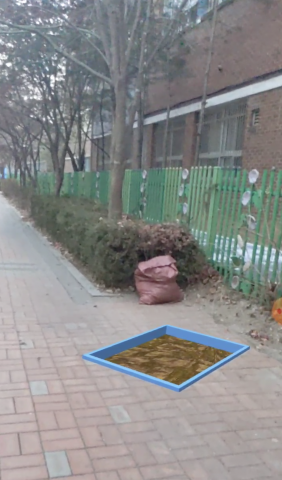This project is an AR portal to the top of a cliff that the user can use to explore a virtual mountain area and find a hidden item.
Screenshots:



gifs:


Inspirations:
I used to explore the apartment complex with my friends when I was little. With great creativity, we imagined different worlds and put ourselves into the shoes of various people and living creatures. One of the scenarios was a treasure hunter, a common recreational game that asks for the teamwork among players to obtain hints and find the hidden items.
Inspired by it, I visualized the portal to another world that hid one of the keys (the item the players have to find and collect). Instead of making it vertical like a door to another world, I located the gate on the floor. This was inspired by my another childhood curiosity and creativity regarding manholes. I always wondered what’s at the end of the manhole, as I’ve heard of different usages of manholes like “it’s for sewage” or “it’s a path to access buried cables,” but have never been inside one. As a child, I would imagine the manhole to be something more grand than its actual usage, like serving as a secret transportational tunnel for spies or a portal to another weird interesting world like Wonderland.
Reflecting these childhood imaginations, I narrated the video as if I’m part of a team of two and am following the hints to collect all three keys before other players do.
Process:
I modified free 3D models I downloaded from online in Blender to create the virtual world beyond the portal. Then, I imported those to unity and scripted accordingly using the AR template.
Because it was my first time using Unity to create my own AR project, I spent a large number of hours looking up how to obtain certain effects I wanted. Although I occasionally got annoyed at C# scripting for it not doing what I asked for (at one point, all I was looking for was a constant rotation at a constant speed, which should be able to obtain with a simple line or two of code, but I had no luck and had to satisfy with other alternative effect…), I think situations like that would less frequently happen as I work on more projects on Unity and get use to C# language syntax and the Unity program itself.
Texturing also took a good amount of time, as one of the models refused to show the texture in Unity. Thanks to Hochi, I was able to learn and apply UV mapping and unwrapping in Blender, which I found it very interesting. It also helped me understand why computer graphics course is requiring students to take 3D calculus and matrices before taking it.
Reflection:
Overall, I enjoyed learning Unity and working on this very first AR project, and I’m happy with the outcome of the project. I appreciate everyone in this class for being supportive and providing opportunities to observe and try new things.